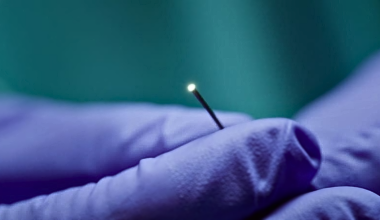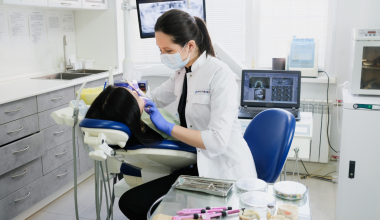Migraine headaches can be tricky to diagnose. Since they are an invisible condition, doctors and patients have to work together to diagnose and treat the condition more closely than some other illnesses. It’s essentially a “self-reported” thing, much like feelings of pain in general and depression.
Online, people complain about not being believed by their doctor, or about receiving what feels like an inaccurate diagnosis.
Migraines affect 12 per cent of Canadians and 25 per cent of Canadian households according to Migraine Canada.
And with approximately 44 per cent of migraines going undiagnosed, I imagine the number is much higher.
Seeing so many people looking for migraine relief, here at The Health Insider, we thought we’d try to help make the process of getting a diagnosis easier.
Receiving the right diagnosis is everything. It means you’re presented with potentially helpful treatment options, not to mention proper insurance coverage.
I talked to Dr. Elisabeth Crisci, the Medical Director at Pacifica MD in Vancouver. She walked me through the process of diagnosing migraines, from before a patient walks in the door, and continuing on to treatment.

Dr. Crisci only performs preventative BOTOX injections as a preventative measure for migraine relief at her clinic, slated to open October 21, 2023.
Most prescription drugs are covered by provincial health insurance, but non-drug remedies may vary in price and coverage.
Establishing the Connection
In order to be set up with a clinic specializing in the treatment of migraines, it is important to first get a referral for a neurologist from your family doctor, or find a headache clinic in your area and request an appointment.
Canadian headache clinics do not require a referral. Some clinics may allow you to book an appointment online, but many require patients to call the clinic first.
Dr. Crisci said before booking an appointment, she asks her patients a few questions in order to make sure this is the appropriate step.
- Medical history
- Medication list
- Medications they’ve tried for migraines
- Frequency and severity
- Private insurance coverage
This process ensures that migraines are the root cause and not a symptom of something else. Bringing your medical records to your appointment can be a helpful tool to ensure accuracy.
Learn more about the importance of having your medical records with The Health Insider’s article here.
Dr. Crisci has a history of working in oncology, so she’ll recommend additional tests and scans to rule out other conditions like cancer.
Eligibility for Treatment

To be eligible for insured BOTOX treatments, patients must have tried a minimum of two medications for migraine relief which were unsuccessful. This can be prescription, but can also be as simple as Tylenol and Advil.
While other prescriptive treatments tend to have a more strict diagnosing criteria, for BOTOX, patients need to experience migraines at least 15 days per month with a duration lasting four or more hours per episode.
Crisci states that private insurance plans tend to cover 80 per cent of the cost of BOTOX for migraines and the Patient Support Program created by the owners of BOTOX can cover the other 20 per cent.
“BOTOX for the treatment of chronic migraine is currently covered under the Alberta government drug plan and it may be covered under the Ontario and Quebec government drug plans if specific criteria are met,” according to Migraine Canada. They continued that BC provincial insurance may also partially cover BOTOX injections in the future.
Don’t fret if you live outside of these provinces though, as Migraine Canada also states that most private insurance plans in Canada will cover all or part of the BOTOX treatment cost.
Patients must see progress to continue to be covered by insurance plans. Doctors must reassess how their patient is reacting to the treatment at least once every year for the patient to stay eligible for reimbursement.
The only out-of-pocket costs, if insured, are pharmacy dispensing fees and the injection fee. Dr. Crisci charges $250 as her fee, but said prices can be as high as $485, especially for cosmetic BOTOX rather than for preventing migraines; the former of which is not covered by provincial health.
Trackers to Bring to Your Appointment
Recommended by Dr. Crisci:
This test establishes a baseline of how severe your migraines are. Not only is this a helpful tool to learn how migraines impact your life, but can also be used to track your progress and ensure treatments are working. Dr. Crisci asks her patients to redo the test every three months.
She also recommends that patients work on a migraine diary tracking symptoms, timeframe, severity, medications, etc. Although a helpful tool, she warned that compliance tends to be low.
The Health Insider recommends the following templates for tracking:
- Migraine Log template – Google Sheets (Overview version)
- Migraine Diary Template – Google Sheets (In depth version)
BOTOX for Migraine Relief
Preventative BOTOX injections for chronic migraines was approved by Health Canada in 2011, a year after it was approved in the US.
Unlike cosmetic BOTOX, migraine treatment consists of shallow injections under the skin instead of into the muscle. The BOTOX blocks the nerve from communicating pain signals to the brain.
Crisci warns that this is not a rescue medication to take while experiencing a migraine, but rather a preventative measure to improve overall quality of life.
With this treatment, patients can expect up to a 50 per cent reduction in migraines per month, as well as a drop in the intensity of the migraines experienced. Unfortunately, BOTOX doesn’t work for everyone, so keeping track of progress is a must.
Dr. Crisci books appointments with her patients every three months for maintenance migraine relief treatments as the BOTOX does not persist in the system. Remember that this is not a cure. It is a treatment.
With PREEMPT BOTOX training under her belt, Dr. Crisci is qualified to complete the 31 injections to prevent migraines.

For those scared of needles, rest assured that the needles are small and injections are very shallow. And the whole process only takes about 10 minutes.
There are various options for migraine treatment that don’t include BOTOX. From medications to wearable devices, there is a fit for every person and every income.
Other Treatment Options for Migraine Relief
Take when experiencing symptoms:
- Simple analgesics
- Aspirin
- Acetaminophen
- Ibuprofen
- Antiemetics
- Gravol
- Dramamine
- Zofran
- Reglan
- Triptans
- Imitrex
- Amerge
- Maxalt
- Zomig
- Axert
- Frova
- Relpax
Take to prevent migraines:
- Angiotensin II blockers
- Anti-convulsants
- Anti-serotonergic drugs
- Beta-blockers
- Calcitonin Gene-Related Peptide pathway monoclonal antibodies
- Calcium channel blockers (calcium channel antagonists)
- Tricyclic antidepressants
- Acupuncture
- Greater occipital nerve block injections
- Technology
- Cefaly (external trigeminal nerve stimulation)
- gammaCore (non-invasive vagus nerve stimulation)
- sTMS (single pulse transcranial magnetic stimulation for migraine)
- Supplements
- Riboflavin (B2) 400mg/day
- Magnesium 400mg/day to 600mg/day
- Co-enzyme Q10 150mg/day

Do you want to learn more about Canadian drug coverage? On September 25, 2023 Migraine Canada is hosting a webinar about how decisions around medications get made, what current coverage looks like across Canada, and the role the patient plays in medical interactions.
Click here to sign up!
I Can’t Get a Diagnosis
Migraines are hereditary; if family members have the same or similar symptoms as you, it might urge your skeptical doctor to take another look.
Try asking family members about their headaches. It may seem like a longshot if they’ve never mentioned migraines before, but I know parents who don’t share their ailments with their kids because they don’t think it’s relevant.
Bringing a migraine diary, like the ones listed above, can also help illustrate your point to your doctor.
Check out the exact diagnostic criteria and additional helpful resources on The Science of Migraine website. Bring this information to your appointment if you feel you aren’t being listened to!
At the end of the day, not every doctor and patient will click. If you feel like you aren’t getting the services you need, you may wish to consider getting a second opinion.
In an age of dwindling doctors and increasing difficulty in getting in touch with your healthcare provider, it’s important to understand your own health, advocate on your own behalf, and advocate loudly if need be, for the proper treatment.
Headache Clinic Locator
Finding a headache clinic in Canada is easy with the Headache Clinic Locator developed by Migraine Canada.
While it is still a work in progress and not every clinic listed links to a website, it can be a handy tool to take some of the guesswork out of finding this type of specialized doctor.
The information provided on TheHealthInsider.ca is for educational purposes only and does not substitute for professional medical advice. TheHealthInsider.ca advises consulting a medical professional or healthcare provider when seeking medical advice, diagnoses, or treatment.










